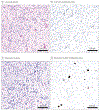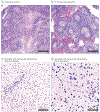Molecular Testing for the World Health Organization Classification of Central Nervous System Tumors: A Review
- PMID: 39724142
- PMCID: PMC12344474
- DOI: 10.1001/jamaoncol.2024.5506
Molecular Testing for the World Health Organization Classification of Central Nervous System Tumors: A Review
Abstract
Importance: Molecular techniques, including next-generation sequencing, genomic copy number profiling, fusion transcript detection, and genomic DNA methylation arrays, are now indispensable tools for the workup of central nervous system (CNS) tumors. Yet there remains a great deal of heterogeneity in using such biomarker testing across institutions and hospital systems. This is in large part because there is a persistent reluctance among third-party payers to cover molecular testing. The objective of this Review is to describe why comprehensive molecular biomarker testing is now required for the accurate diagnosis and grading and prognostication of CNS tumors and, in so doing, to justify more widespread use by clinicians and coverage by third-party payers.
Observations: The 5th edition of the World Health Organization (WHO) classification system for CNS tumors incorporates specific molecular signatures into the essential diagnostic criteria for most tumor entities. Many CNS tumor types cannot be reliably diagnosed according to current WHO guidelines without molecular testing. The National Comprehensive Cancer Network also incorporates molecular testing into their guidelines for CNS tumors. Both sets of guidelines are maximally effective if they are implemented routinely for all patients with CNS tumors. Moreover, the cost of these tests is less than 5% of the overall average cost of caring for patients with CNS tumors and consistently improves management. This includes more accurate diagnosis and prognostication, clinical trial eligibility, and prediction of response to specific treatments. Each major group of CNS tumors in the WHO classification is evaluated and how molecular diagnostics enhances patient care is described.
Conclusions and relevance: Routine advanced multidimensional molecular profiling is now required to provide optimal standard of care for patients with CNS tumors.
Figures




References
Publication types
MeSH terms
Substances
Grants and funding
LinkOut - more resources
Full Text Sources

